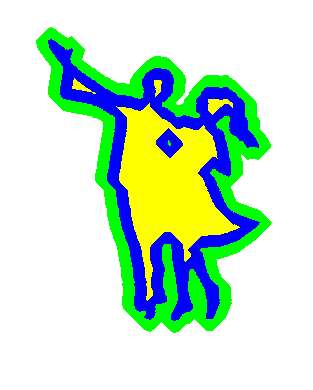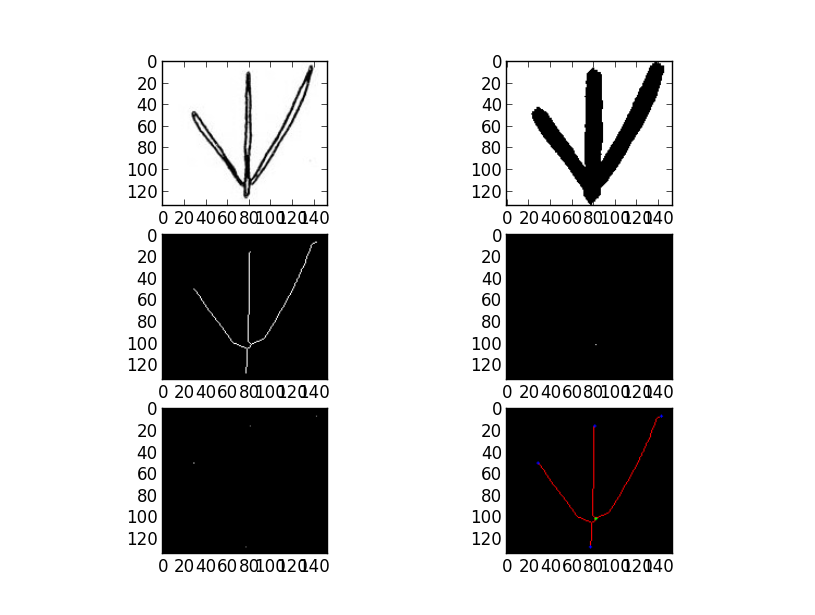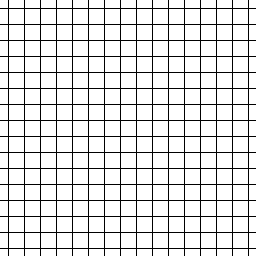|
Structuring Element
In mathematical morphology, a structuring element is a shape, used to probe or interact with a given image, with the purpose of drawing conclusions on how this shape fits or misses the shapes in the image. It is typically used in morphological operations, such as dilation, erosion, opening, and closing, as well as the hit-or-miss transform. According to Georges Matheron, knowledge about an object (e.g., an image) depends on the manner in which we probe (observe) it.See ( Dougherty 1992), chapter 1, page 1. In particular, the choice of a certain structuring element for a particular morphological operation influences the information one can obtain. There are two main characteristics that are directly related to structuring elements: * Shape. For example, the structuring element can be a "ball" or a line; convex or a ring, etc. By choosing a particular structuring element, one sets a way of differentiating some objects (or parts of objects) from others, according to their shape or ... [...More Info...] [...Related Items...] OR: [Wikipedia] [Google] [Baidu] [Amazon] |
Mathematical Morphology
Mathematical morphology (MM) is a theory and technique for the analysis and processing of Geometry, geometrical structures, based on set theory, lattice theory, topology, and random functions. MM is most commonly applied to digital images, but it can be employed as well on Graph (discrete mathematics), graphs, polygon mesh, surface meshes, Solid geometry, solids, and many other spatial structures. Topology, Topological and Geometry, geometrical continuum (theory), continuous-space concepts such as size, shape, convex set, convexity, Connectedness, connectivity, and geodesic distance, were introduced by MM on both continuous and discrete spaces. MM is also the foundation of morphological image processing, which consists of a set of operators that transform images according to the above characterizations. The basic morphological operators are Erosion (morphology), erosion, Dilation (morphology), dilation, Opening (morphology), opening and Closing (morphology), closing. MM was orig ... [...More Info...] [...Related Items...] OR: [Wikipedia] [Google] [Baidu] [Amazon] |
Dilation (morphology)
Dilation (usually represented by ⊕) is one of the basic operations in mathematical morphology. Originally developed for binary images, it has been expanded first to grayscale images, and then to complete lattices. The dilation operation usually uses a structuring element for probing and expanding the shapes contained in the input image. Binary dilation In binary morphology, dilation is a shift-invariant (Translational invariance, translation invariant) operator, equivalent to Minkowski addition. A binary image is viewed in mathematical morphology as a subset of a Euclidean space R''d'' or the integer grid Z''d'', for some dimension ''d''. Let ''E'' be a Euclidean space or an integer grid, ''A'' a binary image in ''E'', and ''B'' a structuring element regarded as a subset of R''d''. The dilation of ''A'' by ''B'' is defined by ::A \oplus B = \bigcup_ A_b, where ''A''''b'' is the translation of ''A'' by ''b''. Dilation is commutative, also given by A \oplus B = B\oplus A = ... [...More Info...] [...Related Items...] OR: [Wikipedia] [Google] [Baidu] [Amazon] |
Erosion (morphology)
Erosion (usually represented by ⊖) is one of two fundamental operations (the other being dilation) in morphological image processing from which all other morphological operations are based. It was originally defined for binary images, later being extended to grayscale images, and subsequently to complete lattices. The erosion operation usually uses a structuring element for probing and reducing the shapes contained in the input image. Binary erosion In binary morphology, an image is viewed as a subset of a Euclidean space \mathbb^d or the integer grid \mathbb^d, for some dimension ''d''. The basic idea in binary morphology is to probe an image with a simple, pre-defined shape, drawing conclusions on how this shape fits or misses the shapes in the image. This simple "probe" is called structuring element, and is itself a binary image (i.e., a subset of the space or grid). Let ''E'' be a Euclidean space or an integer grid, and ''A'' a binary image in ''E''. The erosion of th ... [...More Info...] [...Related Items...] OR: [Wikipedia] [Google] [Baidu] [Amazon] |
Opening (morphology)
In mathematical morphology, opening is the dilation of the erosion of a set A by a structuring element B: :A\circ B = (A\ominus B)\oplus B, \, where \ominus and \oplus denote erosion and dilation, respectively. Together with closing, the opening serves in computer vision and image processing as a basic workhorse of morphological noise removal. Opening removes small objects from the foreground (usually taken as the bright pixels) of an image, placing them in the background, while closing removes small holes in the foreground, changing small islands of background into foreground. These techniques can also be used to find specific shapes in an image. Opening can be used to find things into which a specific structuring element can fit (edges, corners, ...). One can think of ''B'' sweeping around the inside of the boundary of ''A'', so that it does not extend beyond the boundary, and shaping the ''A'' boundary around the boundary of the element. Properties * Opening is idempote ... [...More Info...] [...Related Items...] OR: [Wikipedia] [Google] [Baidu] [Amazon] |
Closing (morphology)
In mathematical morphology, the closing of a set (binary image) ''A'' by a structuring element ''B'' is the erosion of the dilation of that set, :A\bullet B = (A\oplus B)\ominus B, \, where \oplus and \ominus denote the dilation and erosion, respectively. In image processing, closing is, together with opening, the basic workhorse of morphological noise removal. Opening removes small objects, while closing removes small holes. Example Perform Dilation ( A\oplus B ): Suppose A is the following 11 x 11 matrix and B is the following 3 x 3 matrix: 0 0 0 0 0 0 0 0 0 0 0 0 1 1 1 1 0 0 1 1 1 0 0 1 1 1 1 0 0 1 1 1 0 0 1 1 1 1 1 1 1 1 1 0 0 1 1 1 1 0 0 0 1 1 0 1 1 1 0 1 1 1 1 0 0 0 1 1 0 1 1 1 0 1 0 0 1 0 0 0 1 1 0 1 1 1 0 1 0 0 1 1 1 1 1 1 0 0 1 1 1 1 1 1 1 0 0 0 0 1 1 1 1 1 1 1 0 0 0 0 0 0 0 0 0 0 0 0 0 0 For each pixel in A that has a value of 1, superimpose B, with t ... [...More Info...] [...Related Items...] OR: [Wikipedia] [Google] [Baidu] [Amazon] |
Hit-or-miss Transform
In mathematical morphology, hit-or-miss transform is an operation that detects a given configuration (or pattern) in a binary image, using the morphological erosion (morphology), erosion operator and a pair of Disjoint sets, disjoint structuring elements. The result of the hit-or-miss transform is the set of positions where the first structuring element fits in the foreground of the input image, and the second structuring element misses it completely. Mathematical definition In binary morphology, an image is viewed as a subset of a Euclidean space \mathbb^d or the integer grid \mathbb^d, for some dimension ''d''. Let us denote this space or grid by ''E''. A structuring element is a simple, pre-defined shape, represented as a binary image, used to probe another binary image, in morphological operations such as erosion (morphology), erosion, dilation (morphology), dilation, opening (morphology), opening, and closing (morphology), closing. Let C and D be two structuring elements ... [...More Info...] [...Related Items...] OR: [Wikipedia] [Google] [Baidu] [Amazon] |
Georges Matheron
Georges François Paul Marie Matheron (2 December 1930 – 7 August 2000) was a French mathematician and civil engineer of mines, known as the founder of geostatistics and a co-founder (together with Jean Serra) of mathematical morphology. In 1968, he created the Centre de Géostatistique et de Morphologie Mathématique at the Paris School of Mines in Fontainebleau. He is known for his contributions on Kriging and mathematical morphology. His seminal work is posted for study and review to the Online Library of the ''Centre de Géostatistique'', Fontainebleau, France. Early career Matheron graduated from ''École Polytechnique'' and later '' Ecole des Mines de Paris'', where he studied mathematics, physics and probability theory (as a student of Paul Lévy). From 1954 to 1963, he worked with the French Geological Survey in Algeria and France, and was influenced by the works of Krige, Sichel, and de Wijs, from the South African school, on the gold deposits of the Witwatersrand ... [...More Info...] [...Related Items...] OR: [Wikipedia] [Google] [Baidu] [Amazon] |
Binary Image
A binary image is a digital image that consists of pixels that can have one of exactly two colors, usually black and white. Each pixel is stored as a single bit — i.e. either a 0 or 1. A binary image can be stored in memory as a bitmap: a packed array of bits. A binary image of 640×480 pixels has a file size of only 37.5 Kibibyte, KiB, and most also compress well with simple Run-length encoding, run-length compression. A binary image format is often used in contexts where it is important to have a small file size for transmission or storage, or due to color limitations on displays or printers. It also has technical and artistic applications, for example in digital image processing and pixel art. Binary images can be interpreted as subsets of the square lattice, two-dimensional integer lattice ''Z''2; the field of Mathematical morphology, morphological image processing was largely inspired by this view. Terminology Binary images are also called ''bi-level'' or ''two-level ... [...More Info...] [...Related Items...] OR: [Wikipedia] [Google] [Baidu] [Amazon] |
Subset
In mathematics, a Set (mathematics), set ''A'' is a subset of a set ''B'' if all Element (mathematics), elements of ''A'' are also elements of ''B''; ''B'' is then a superset of ''A''. It is possible for ''A'' and ''B'' to be equal; if they are unequal, then ''A'' is a proper subset of ''B''. The relationship of one set being a subset of another is called inclusion (or sometimes containment). ''A'' is a subset of ''B'' may also be expressed as ''B'' includes (or contains) ''A'' or ''A'' is included (or contained) in ''B''. A ''k''-subset is a subset with ''k'' elements. When quantified, A \subseteq B is represented as \forall x \left(x \in A \Rightarrow x \in B\right). One can prove the statement A \subseteq B by applying a proof technique known as the element argument:Let sets ''A'' and ''B'' be given. To prove that A \subseteq B, # suppose that ''a'' is a particular but arbitrarily chosen element of A # show that ''a'' is an element of ''B''. The validity of this technique ... [...More Info...] [...Related Items...] OR: [Wikipedia] [Google] [Baidu] [Amazon] |
Euclidean Space
Euclidean space is the fundamental space of geometry, intended to represent physical space. Originally, in Euclid's ''Elements'', it was the three-dimensional space of Euclidean geometry, but in modern mathematics there are ''Euclidean spaces'' of any positive integer dimension ''n'', which are called Euclidean ''n''-spaces when one wants to specify their dimension. For ''n'' equal to one or two, they are commonly called respectively Euclidean lines and Euclidean planes. The qualifier "Euclidean" is used to distinguish Euclidean spaces from other spaces that were later considered in physics and modern mathematics. Ancient Greek geometers introduced Euclidean space for modeling the physical space. Their work was collected by the ancient Greek mathematician Euclid in his ''Elements'', with the great innovation of '' proving'' all properties of the space as theorems, by starting from a few fundamental properties, called '' postulates'', which either were considered as evid ... [...More Info...] [...Related Items...] OR: [Wikipedia] [Google] [Baidu] [Amazon] |
Pixel
In digital imaging, a pixel (abbreviated px), pel, or picture element is the smallest addressable element in a Raster graphics, raster image, or the smallest addressable element in a dot matrix display device. In most digital display devices, pixels are the smallest element that can be manipulated through software. Each pixel is a Sampling (signal processing), sample of an original image; more samples typically provide more accurate representations of the original. The Intensity (physics), intensity of each pixel is variable. In color imaging systems, a color is typically represented by three or four component intensities such as RGB color model, red, green, and blue, or CMYK color model, cyan, magenta, yellow, and black. In some contexts (such as descriptions of camera sensors), ''pixel'' refers to a single scalar element of a multi-component representation (called a ''photosite'' in the camera sensor context, although ''wikt:sensel, sensel'' is sometimes used), while in yet ... [...More Info...] [...Related Items...] OR: [Wikipedia] [Google] [Baidu] [Amazon] |






